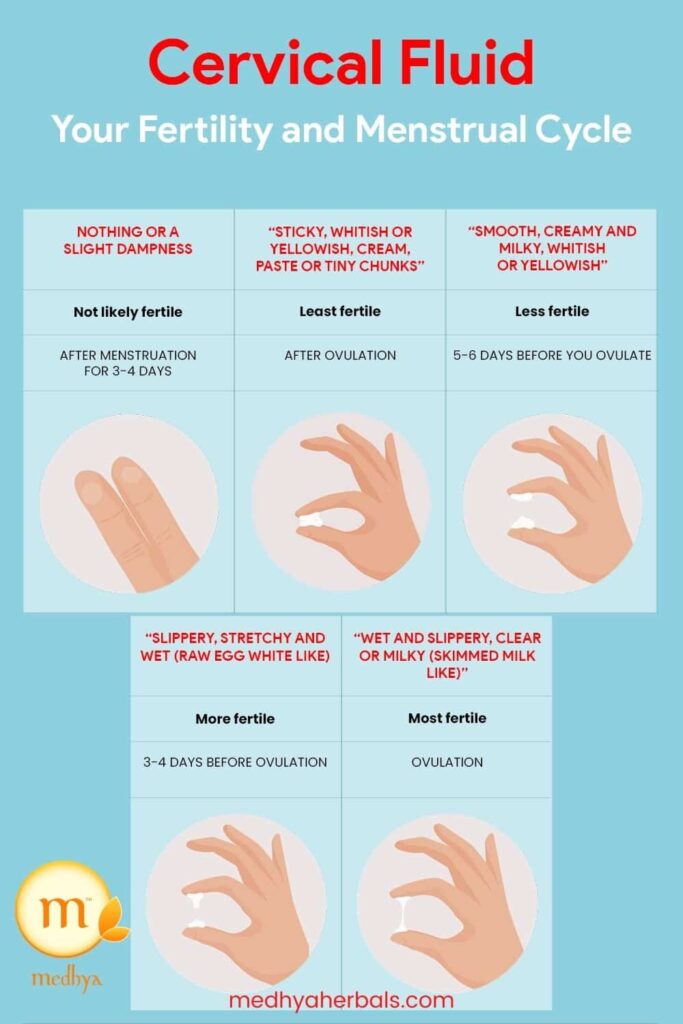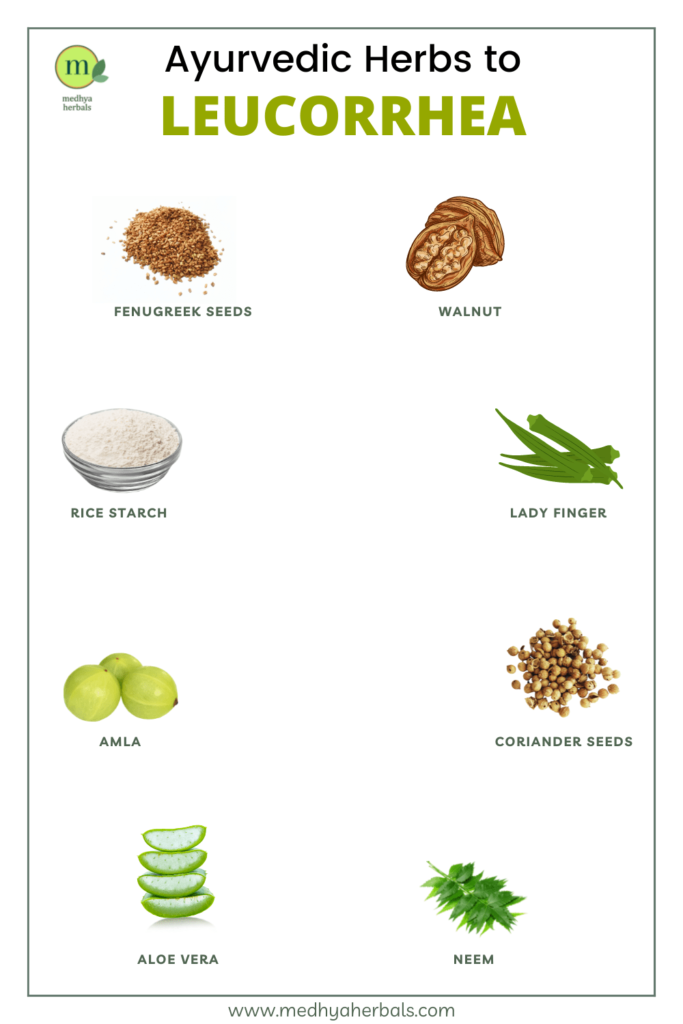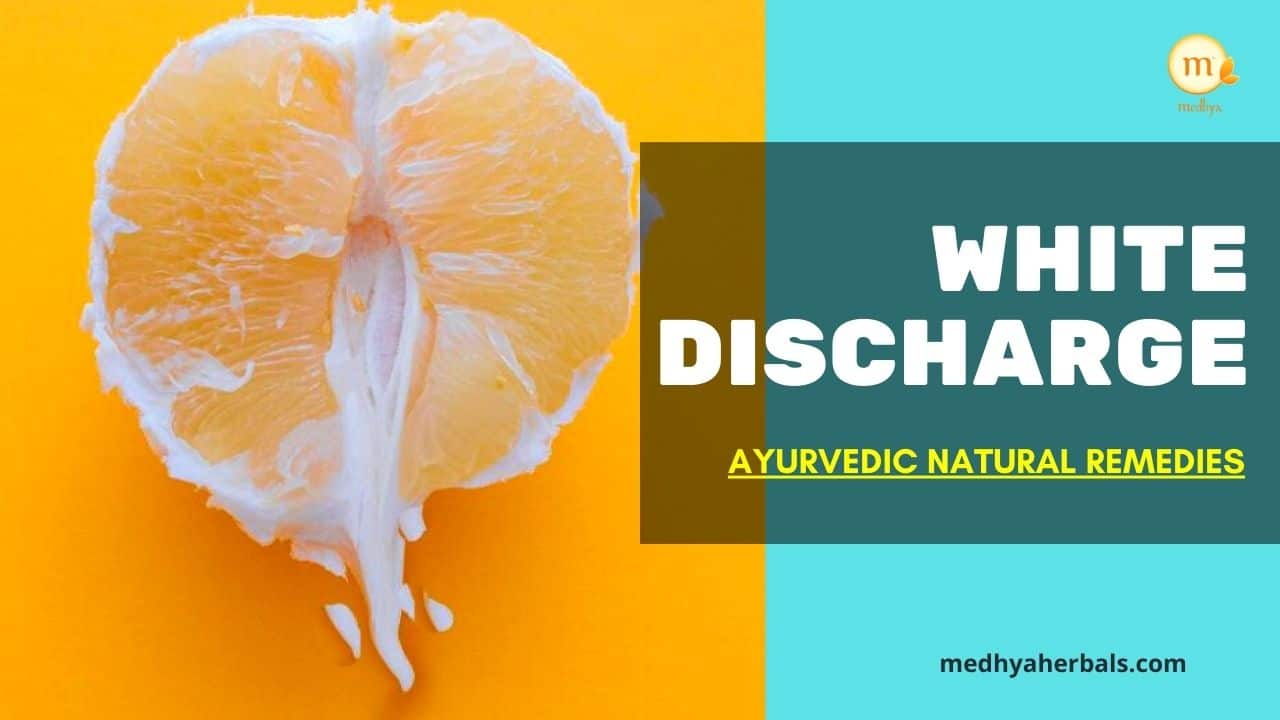What causes thick white discharge before period? How can I stop white discharge? And whether it is even normal to have daily white discharge from vagina are surely few of your top worries that brought you here.
Now whether you are concerned about daily white discharge or looking for natural ways to get rid of excess white discharge, you will find your answers here.
We will go through the types of white discharge (what’s normal and what’s not) in specific, causes of abnormal vaginal discharge before period and Ayurvedic natural ways to address the problem of white discharge. Let’s get started!
Before we begin, here are some quick facts for you:
- Vaginal discharge could be natural and normal. And it can also happen due to yeast infection or other causes.
- Normal vaginal discharge is milky white or thin and clear, without any smell.
- Female Reproductive system organs as uterus, cervix and vagina all make the fluid, which then gets discharged through the vaginal canal and termed as vaginal fluid.
- Vaginal discharge is a mixture of fluid from the reproductive organs, healthy bacteria which help to maintain pH and flora of vaginal canal, and dead cells from the reproductive system.
- Abnormal discharge can contain harmful bacteria, excess fluids, pus and blood from the reproductive organs.
Normal White Discharge
White Discharge is commonly observed during pregnancy, during ovulation, and during different phases of menstrual cycle. The quantity of vaginal discharge and its thickness varies along the cycle.
In most of the cases, white discharge is a usual step of cleansing that your reproductive system is performing and there is nothing to be concerned about.
Here’s how your vaginal discharge varies during normal menstrual cycle. It is also called cervical fluid as it is produced from the cervix, a gland that secrets it under the action of hormones.
Your Fertility and White Discharge
Normal vaginal discharge is usually white, but it may also look yellowish sometimes.
During the follicular phase of menstrual cycle Estrogen hormone rises and it peaks at ovulation. Estrogen makes the vaginal discharge transparent and watery with a stretchy texture. That’s why the most fertile type of white discharge feels wet with egg white like consistency and is stretchy. This happens few days before ovulation.
Thicker white discharge is more commonly observed in the luteal phase of the menstrual cycle, when Progesterone rises in the body. The hormone of progesterone turns vaginal discharge white and cloudy in color.
White and thick discharge denotes infertile vaginal discharge or cervical fluid. It cannot support sperms and ovum for fertility. Hence, your chances to conceive go down almost immediately after ovulation, when your discharge becomes thick, creamy and white.

Here’s How Normal Vaginal Discharge Changes
Furthermore, for each woman, the volume of vaginal discharge may increase or change:
- before menstruation: Thick, white, cloudy, creamy
- at the time of ovulation: Wet, Stretchy, Thin and Slippery in nature
- Early Sign of pregnancy: Vaginal discharge before period could also happen in first trimester. This type of discharge is generally bulky, without smell, thicker and creamier compared to regular discharge.
- During Pregnancy: Thick, milky, white discharge that is velvety in texture happens during third trimester of pregnancy, when the body starts to prepare for the delivery.
- due to sexual arousal: thick, white, creamy and bulky discharge with no smell
- and when you are on hormone replacement therapy (HRT): Bulky and creamy discharge
- or on contraceptives: Birth control pills are hormone based and affect our natural hormone balance. They often lead to an increase in the level of white discharge.
- during menopause the discharge decreases in volume due to a natural drop in estrogen levels.
These changes in the discharge are all normal and vary from woman to woman.
Abnormal White Discharge | Leucorrhea
Abnormal white discharge is a common health issue faced by women at all ages, ranging from early years to even after menopause. It is called as Leukorrhea or Leucorrhea in medicine terminology.
Leucorrhea may happen in adult women due to infections, inflammation and hormonal imbalances. Most of the common symptoms related to leukorrhea is general weakness and itching in vaginal canal.
For children and for women post menopause, excess white discharge or any abnormal discharge usually indicates presence of health issues such as infections or hormonal imbalances that need to be addressed.
Hence, it should be taken more seriously if any symptom is observed.
Causes and Types of White Discharge | Leukorrhea
Ayurveda states that abnormal white discharge is not a disease in itself. It is in fact, a health symptom that can arise due to varying factors ranging from poor hygiene to serious health conditions as cervical cancer.
The term Leukorrhea is applied to cases of vaginal discharge that is excess in quantity (meaning it happens regularly and or in large amounts). Leukorrhea is non-hemorrhagic (without blood) in nature.
It is usually benign in nature, hence it can be treated by addressing the root cause.
Here’s are some of the most commonly observed causes of abnormal white discharge:
Physiological Leukorrhea
Pysiological leucorrhea is common and is caused by defense mechanism of the body to restore the chemical balance of vaginal canal. It also helps to maintain the flexibility of the vaginaal muscles and the surrounding tissues.
White discharge in this happens under the action of Estrogen hormone. Hence, for women with following health conditions white discharge may be a frequent or daily:
- Diabetes
- Nutritional Deficiencies (Iron)
- Thyroid problems
- PCOS
- Insulin resistance
- High Estrogen
- Hormonal imbalances
- Digestive Problems and toxin buildup in the digestive tract
- Injury or Vaginal atrophy
Physiological leucorrhea may also occur during ovulation, pregnancy and under the action of hormone based treatment such as birth control pills.
Pathological Leukorrhea
This type of white discharge happens under the action of inflammation and congestion of the reproductive organs and vaginal canal.
Vaginal discharge due to infections may be yellowish, white curdy, lumpy, colored or thick white in nature. It may be smelly or carry not smell at all.
Additionally, pathological leucorrhea may lead to additional symptoms such as fatigue, back pain, burning sensation, fever and itchiness.
- It can be due to infections as Trichomonas vaginalis, Candida albicans, Chlamydia trachomatis, Neisseria gonorrhoeae, or mixed bacterial infections.
- It is also due to chronic cervicitis, cervical dysplasia, malignancy, or due to senile vaginitis.
Symptoms of White Discharge | Leukorrhea
Sometimes leukorrhea and its symptoms becomes so severe that it overshadows other symptoms of the actual disease.
Most prevalent symptoms
- Irritation and itching on genital organs, which becomes worse at night
- Foul smelling vaginal discharge
- Lack of sexual desire
- Lethargy and fatigue
Moderately prevalent symptoms
- Constipation
- Indigestion and Heaviness
- Stress or Anxiety
- Frequent mood changes
- Pain in stomach/lower back pain
Less prevalent symptoms
- Black dark circle around the eyes
- Anorexia
- Irregular periods
Leukorrhea | Abnormal White Discharge – An Ayurvedic View
In Ayurveda, white discharge is known as Shweta pradara. Shweta means white and pradara means excessive flow.
White discharge in Ayurveda falls in the category of “Yonivyapada” or health disorders of female reproductive system health issues.
Shweta pradara develops due to imbalances of Kapha and Vata, but mainly Kapha. This is because Kapha dosha is the main causative factor for any discharge.
So, when Kapha is aggravated, it produces white and painless vaginal discharges.
Causes of white discharge according to Ayurveda
Ayurvedic medicine points out specific causes of white discharge from the vagina. These include:
The main causes as per Ayurveda are-
- Viruddhahara– Unhealthy food
- Ashuchi– Unhygienic activities and infection
- Madyapana– Excessive alcohol intake
- Ajeerna – Undigested food and Ama (Toxin buildup)
- Adhyashana– Continuous eating which leads to indigestion
- Bharavahana – Excess weight lifting
- Garbhapata – Too many abortions
- Abhighata– Injury
- Shoka – Grief and stress
Ayurvedic Treatment for White Discharge
In Ayurveda, generally, the use of drugs having Bitter (Katu) and Astringent (Kashaya) rasa is useful. Also, Balya chikitsa (use of Rasayana drugs) is beneficial to promote strength.
Proper food habits, sleep, and exercise is essential for the removal of toxin buildup in the body, which is responsible for Leukorrhea.
1. Ayurvedic Diet for White Discharge
Many times you must have heard the phrase, “You are what you eat.” The functioning of your body depends to a large extent on what goes into it. This could be germs, or food, as in this case.
If your discharge is a result of infections, then you can choose to eat food that will help your body fight the infection. Food for health!
Some foods can help you alleviate leukorrhea, and you should embrace these. However, some can make the condition worse and should be avoided.
Best and Worst Foods for White Discharge
| Food Groups | Best foods | Worst foods |
| Fruits/Nuts | Apples, Black plums, Cranberries, Pears, Oranges, Pomegranate, Bananas | Peanuts, Excessive lemons |
| Vegetables | Leafy Greens, Salad, Onions, Okra, Steamed vegetables, Carrot, Vegetable soup, Potatoes | Mushrooms, Beans, Peas |
| Grains/Legumes | Pulses, Brown Rice | |
| Spices/Herbs | Fenugreek, Ginger, Garlic, Neem, Coriander seeds | Salt, Chilies, Tamarind |
| Drinks & Others | Water, Yogurt, Milk, Fresh cranberry juice (without any sugar, once a day) Amalaki powder with add honey in a glass of water | Eggs, Meat, Coffee And Tea, Bread, Fried Foods, Spicy And Sour Foods, Excessive salt, Sweets, Alcohol |
2. Ayurvedic Tips and Natural Remedies

- Hydrotherapy/ Hip bath/Cold sitz bath are effective in increasing blood circulation in the vagina, cold water bath also helps relieve congestion in the pelvic region. You can take regular (2-3 times a week) hydrotherapy to speed up healing.
- Regular exercise regime helps in the treatment of white discharge; as exercises improve blood circulation and build immunity to bacterial attacks.
- Aromatherapy with antimicrobial essential oils of rosemary, oregano and sandalwood is an effective natural cure for Leukorrhea.
- Good sleep and rest also facilitate faster healing.
- Herbal tea such as green tea blended with sage or blackberry leaves facilitates in treatment of leukorrhea.
- Some of the herbal remedies like red raspberry with white pod lily, lotus seeds, and root are used to treat Leukorrhea.
- Apply yoghurt on vagina to control itching and white discharge.
Personal Hygiene and Guidelines for prevention of vaginal discharge
- Avoid sanitary napkins, deodorants, sprays, and other irritants during treatment as they can aggravate Leukorrhea.
- Don’t douche.
- During an infection, use pads rather than tampons if menstruation occurs.
- Maintain good hygiene, especially in the genital areas to prevent any bacterial infections.
- Use protection during intercourse to prevent sexually transmitted disease.
- Make a habit of wiping from front to back after bowel release. This will prevent the germs and fecal matter from entering the vagina.
- Change your undergarments every day. Never wear wet or dirty underwear.
- Wear cotton undergarments. Stay away from synthetic, tight and uncomfortable underpants.
- Keep the vaginal area dry as sweat or moisture can lead to yeast growth and infections. Wipe the private parts after bowel movement and urination.
3. Yoga for White Discharge
Yoga is a set of traditional exercises that are designed to relax you and keep you in optimal health. Numerous Yoga asanas exist, and some are particularly beneficial for white discharge.

Pranayama is a set of breathing exercises. Breathing routines also abound that can positively affect this condition. They have the added benefit of being relaxing and uplift the mood. Examples of such exercises are:
- Supta Bajrasana
- Parvatasana,
- Salabhasana
- Bhadrasana
- Garbhasana
- Sarbangasana
- Mathsyasana
- Bhastrika
- Anulom Vilom
4. Ayurvedic Medicines to Treat White Vaginal Discharge
Ayurvedic medicine uses a lot of herbs in the management of diseases. These herbs are utilized in their natural form or with little processing. Hence, they are used with much of their natural goodness intact, so that the patient can get the maximal benefit.
Because Ayurvedic herbs have undergone very little processing, these herbs give little to no side effects. You just be sure to use them according to your recommendation. The results will be tremendous.
Back to the point. Let’s look into the Ayurvedic herbs to cure white discharge or leukorrhea.

1. Fenugreek seeds
These seeds can help to solve the problem of white discharge. Fenugreek serves to boost immunity, thus preventing infections.
They also help to keep the vagina healthy by increasing pH (decreasing acidity) in the vagina. Furthermore, fenugreek seeds boost the natural microbial flora in the vagina.
Guideline for consumption
- Boil fenugreek seeds in 500ml of water for 30 minutes.
- Wait for the water to reduce to half.
- Strain the mixture and leave it to cool.
- You can choose to drink this water
- It can also be used to wash the vagina several times daily.
2. Ladyfinger
It is also called bhindi. More commonly, it is known as okra. Ladyfinger helps to reduce mucus in the body. By so doing, vaginal discharge is also reduced.
Guideline for consumption
- Cut into small pieces.
- Boil in water till the volume of water is reduced to half
- Allow to cool and strain
- Add in some honey
- Drink twice or thrice a day
- Alternatively, soak okra in yogurt and drink
3. Coriander seeds
Coriander is beneficial because it has antioxidant properties. Also, it can eliminate toxins and microbes from the body, which could have caused infections.
Guideline for consumption
- Soak in water overnight and drink on empty stomach in the morning
- You could also boil in water till the water volume halves, strain, and drink
- Use coriander leaves in your cooking.
- Decoction of coriander seeds can be used to wash the vagina
4. Amla (Indian gooseberry)
Amla is a superfood. It is rich in vitamin C and can keep off infections, due to its antimicrobial and immune-boosting effects.
Guideline for consumption
- Make 1-2 teaspoons of the powder into a paste and take it twice daily.
- The paste could also be applied to the affected area of the vaginal tract.
- You could alternatively boil this powder in water and drink it in the morning on an empty stomach.
- Eat fresh amla fruit.
5. Tulsi
Tulsi is packed with loads of medicinal benefits.
Guideline for consumption
- Grind tulsi with water.
- Add some honey.
- Drink twice daily.
- You could drink with milk if you please.
6. Guava leaves
This is particularly helpful with the vaginal discharge that comes with itching.
Guideline for consumption
- Boil some guava leaves in the water
- Allow it to cool
- Drink twice a day
7. Rice starch
Rice starch is simply the water in which you have boiled rice. It is highly effective for physiological leucorrhea, caused by excess heat in the body.
Guideline for consumption
- Drink regularly to eliminate the white discharge
8. Aloe vera
Aloe vera helps to manage excessive discharge, itching, and burning sensation. It also tones up and strengthens the uterus.
Guideline for consumption
- Drink fresh aloe vera juice daily.
- Apply the fresh pulp of aloe vera over the affected area of the vagina.
- Mix aloe vera juice with an equal amount of water and use this to wash the vagina. It gives relief from itching and burning.
9. Neem
Neem is an Ayurvedic medicinal herb that has antibacterial, antifungal, antioxidant, anti-inflammatory, & antiseptic properties. These make it a good herb for treating leukorrhea.
Guideline for consumption
- Squeeze out 20ml of juice from neem leaves.
- Mix with 20ml of water.
- Drink this twice daily.
Alternatively,
- Boil fresh neem leaves in water.
- Allow to cool down.
- Use this water to wash the vagina
Also,
- Apply neem oil to the affected area of the vagina.
10. Coconut
Coconut possesses antioxidant, anti-inflammatory, anti-bacterial, and anti-viral properties. It eliminates toxins from the body. These properties make it excellent for curing white discharge.
Guideline for consumption
- Drink green coconut water daily.
- Apply coconut oil directly to the affected area of the vagina.
- Mix coconut oil with some drops of neem and apply to the affected area.
11. Walnut
Walnut will help speed up the healing process. This is because it has astringent properties.
Guideline for consumption
- Boil fresh walnut leaves in water for 15-20 minutes, allow to cool, and use this to wash.
- You could also boil powdered walnut leaves in water. Cool, strain, and use to wash.
- Soak walnut overnight in a glass of water. Eat in the morning on an empty stomach.
Conclusion
Navigating the complexities and concerns surrounding white discharge or leucorrhea can often feel overwhelming. Many women grapple with this condition, and the search for effective solutions can sometimes seem endless. It’s essential to recognize that you’re not alone in this journey, and finding relief from leucorrhea is a shared aspiration among countless individuals.
At Medhya Herbals, we believe in the power of Ayurveda and its time-tested, holistic approach to health. Our Ayurvedic doctors delve deep into understanding the root causes of conditions like leucorrhea, ensuring that treatments address the core issue and offer lasting relief. Ayurveda’s natural remedies and personalized treatment plans offer a beacon of hope for many who have been searching for a sustainable solution.
If you’re seeking guidance and a tailored approach to managing white discharge, we invite you to schedule a consultation with our expert Ayurvedic doctors. Together, we can chart a path to wellness, ensuring your well-being remains at the forefront of every decision.


there may be multiple reasons for white discharge and they are easily treatable. home remedies are always useful for white discharge you can use there may be a healthy choice for many women.